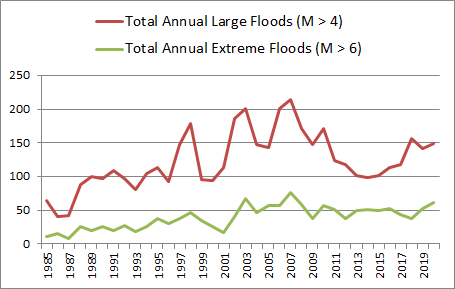Photo: Bill McMannis, CC BY 2.0, via Wikimedia Commons
Late last month, Hurricane Helene drenched the Southwest United States. Devastating floods hit communities in the Gulf Coast and Southern Appalachia. The storm killed more than 200 people and destroyed billions of dollars of property.
As relief efforts begin to put the pieces back together, many are left wondering if the norms of extreme weather in America have changed. Was this unprecedented storm a freak occurrence or a new precedent?
Albert Kettner is the associate director of INSTAAR and the director of the DFO Flood Observatory (formerly the Dartmouth Flood Observatory). Since he took over the observatory in 2019, Kettner has tracked precipitation, drought and flooding around the world. His observations are built on the foundations laid by INSTAAR Senior Research Scientist Robert Brakenridge, who founded the observatory in 1993.
According to Kettner's data, extreme floods like the ones that hit Appalachia last month have become more common in the 21st century.

Number of large and extreme floods on an annual basis from 1985 to 2020 (Credit: Robert Brakenridge). For comparison, the Appalachia floods caused by Hurricane Helene in 2024 were in the extreme category. Flood magnitude =LOG(Duration x Severity x Affected Area). The graph is based on data from the DFO Flood Observatory, accessible at https://floodobservatory.colorado.edu/Archives/.
It's not the case that the world is getting wetter, in fact many places are becoming more arid. Rather, really big floods, which were previously rare, are happening more often.
According to Kettner, the reasons behind this are hard to parse out. In some cases, it could be that warmer air temperatures allow the atmosphere to hold more moisture. In other cases, extreme flooding might be driven by urban infrastructure that lacks adequate drainage. Most of the underlying causes of catastrophic floods boil down to two categories: climate change and human changes to the landscape.
"Flooding is both a derivative of precipitation and the area where that precipitation is landing," Kettner explained.
As the climate continues to shift, so too will patterns of extreme weather. Amidst this uncertainty, tools like the DFO Flood Observatory can also help humanity better respond to natural disasters. Kettner has leveraged his expertise in flood tracking to create inundation maps for the United Nations World Food Programme in the past. He hopes to foster more collaboration between aid organizations and the observatory in the future.






